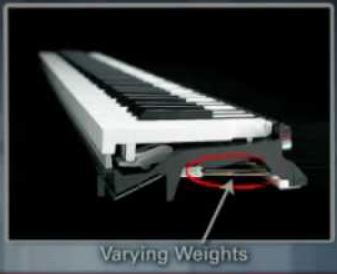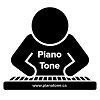The most common question I get on my site and my YouTube channel is “how important is it to have fully weighted graded hammer action keys as opposed to weighted keys that are not graded, or even semi-weighted keys?”. Although there are many piano purists out there that will say “You MUST have fully weighted graded hammer action keys”, there really is a lot more to it than that – it depends on you, your goals & desires, your situation, and your budget. I will also be touching on “touch sensitivity” (get it? “touching on?”) which is a related topic when shopping for a digital piano.
What Are “Weighted Keys”?
Weighted keys are how digital piano manufacturers try to mimic the “feel” of playing an acoustic piano. A very simplified way of describing what happens on an acoustic piano (but more than adequate for this post) is that when you press a key (which is actually like a long see-saw you can only see the front of) on an acoustic piano, it swings a hammer that strikes a string that vibrates and that makes the sound you hear.

So because of that physical thing that’s happening (swinging a hammer), you can understand why it feels “harder” to press down a key on an acoustic piano – you have to swing that hammer! And, the strings on the left of the piano (that produce the “bass’ier” notes) are bigger, so as a result the keys on the left side of the piano are slightly harder to play than the ones on the right side of the piano, which strike much smaller strings. If you want a more detailed explanation of how keys work on an acoustic piano, this is a great animation you can check out: How Does A Grand Piano Work?

So in a digital piano, manufacturers try to mimic the feel of swinging that hammer by adding a counterweight to each key – so when you press the key, it has to lift the counterweight; this lifting of a counterweight (depending on the quality) can come pretty close to mimicking the feeling of swinging the hammer on an acoustic piano.
Types Of Weighted Keys
Fully Weighted Graded Hammer Action
The best version of weighted keys on a digital piano is “Fully Weighted Graded Hammer Action”. With this type, each key has its own specific counterweight (the “fully weighted” part) and the weight of each key as you progress from the left to the right is slightly lighter (the “graded” part). As you would expect, this is also usually the most expensive type of weighted action.
Variations
Note that not all fully weighted graded hammer action keyboards are created equal. There are some that are fully weighted, but they are “graded” in groups (instead of each key having a specific weight). So for example, the first quarter of the keyboard will all have the same weight, and the next quarter all have the same slightly lighter weight and so on. These usually tend to be slightly less expensive.
Fully Weighted Hammer Action (Not Graded)
This is the next step down, where the keys are fully weighted, but all keys have the same weight across the keyboard. These are usually weighted with the weight you would find in the centre area of the keyboard (so the lower notes may be a tiny bit easier to play than on an acoustic piano, and the higher notes may be slightly harder to play).
Semi-Weighted
While you might assume that “semi-weighted” means that there are still weights being used (but they are just lighter), this is often not the case. Typically when you hear “semi-weighted” it means that some type of spring mechanism is being used to add some resistance to pressing a key (there are some keyboards that may use smaller weights in combination with a spring, but usually you are just dealing with springs).
Comparison Of The Above Actions
Fully weighted graded hammer action keys (with individual weights per key) will give you the closest approximation to playing an acoustic piano. I’m sure a very experienced pianist familiar with acoustic pianos would notice a difference between a digital piano with individual weights per key (like the Roland FP-30) and one that is weighted in groups (as a relative beginner only in my 2nd year of playing, I doubt I could tell the difference).
As you go down to a piano that is fully weighted but not graded (like the Alesis Recital Pro or the Inovus i88) the difference will be more noticeable; once again an experienced pianist will almost surely notice this, and someone at my level? Probably. But, the fact that you are still getting hammer action and an “average” resistance when you play means that you will still be reasonably prepared to play an acoustic piano.
When you step down to a semi-weighted (typically spring action) digital piano, the difference between that an acoustic piano is huge. You are still getting SOME resistance when you play (so yes, it is better than NO resistance), but the amount of resistance and even more so how the resistance feels will be immediately noticeable. This means that the transition from a semi-weighted digital piano to an acoustic piano would be pretty significant.
Touch Sensitivity
Before talking about how important is it for YOU to worry about what type of weighted keyboard is right for you, I wanted to talk about touch sensitivity. When you go back to thinking about the hammer swinging on an acoustic piano, think about what happens when you hit the key REALLY hard or REALLY soft. If you hit it hard, you guessed it – hammer hits the string harder so the sound will be louder, and you may also hear another sound of the hammer actually impacting the string (as opposed to just the strings vibrating after they are hit). And vice versa, when you play a key softly, the hammer just touches the string so the sound is quieter.
This is mimicked in digital pianos (and many plain keyboards as well) with “touch sensitivity”. This is where some sort of velocity sensor detects how hard you hit a key, and adjusts the volume up or down accordingly. In mid range and higher end digital pianos, the piano may also change the sound being played as well as the volume (for example on my Roland FP-30, you can hear a distinct sound of the hammer striking a string when you play hard). Most keyboards that have touch sensitivity also have 3-5 (or more) “levels” so you can adjust how it reacts based on how hard you tend to play.
Touch sensitivity allows you to play with some feeling and expression, playing softly or not so softly as the piece warrants. In my opinion, this is MANDATORY in any keyboard or digital piano; most do have touch sensitivity, but if they do not, I would not recommend that instrument.
The Verdict: What Weighting Is Right For YOU?
Whether or not you should be worrying about whether you MUST have fully weighted graded hammer action really depends on you: your goals, your situation and your budget. The first and possibly most important question you have to ask yourself is:
“How important is it to YOU to be able to make the transition between a digital piano and an acoustic piano as smooth as possible?”
- Do you own or hope/plan to own an acoustic piano?
- Are you taking formal piano lessons from an instructor on an acoustic piano (and you expect to be taking formal music grading tests which will be on an acoustic piano)?
- Do you hope to be playing an acoustic piano at your school, church, family member’s house etc?
If it IS important to you to be able to make that transition as smooth as possible, then you should try to get the most realistic weighting you can (fully weighted graded hammer action). And if you cannot find a piano within your budget that has that weighting system, you could look for a used one, or you could consider a cheaper option with fully weighted (not graded) keys – as I mentioned before, this is not the best option, but it is still reasonably close and a much better approximation than semi-weighted.
If it is NOT important to you to make that transition as easy as possible, then – it really is up to you! Before making a decision though, I would recommend trying out as many different pianos in stores as you can so you can see what you like and what you don’t (but make SURE it has touch sensitivity!).
I’d like to share how this decision process worked for me. When I first started playing, I knew very little about weighted keys vs non-weighted keys and actually my first keyboard was an entry level Casio that I bought because the SALES-person (emphasis on “sales”) told me that this keyboard (that did not have weighted keys) was “just like a piano” because it had touch sensitivity. As I learned more, I decided to upgrade to an Alesis Recital Pro which had non graded but fully weighted keys and I loved how the keyboard felt (so for me, even though I have no acoustic pianos in my life, I would still like to have the transition be reasonably smooth, and I just happen to prefer the feel of a weighted keyboard) so I will always own something weighted. I should also note that I know of multiple professional gigging musicians who prefer semi-weighted pianos, so . . . to each his own.
There are also some advantages to semi-weighted keyboards:
- they are WAY lighter; my Roland FP-30 weighs 40 pounds – the Alesis Recital (not the pro but the semi-weighted version) is 16 pounds. So if portability is important to you, this may be something to consider
- they are usually much cheaper
- if you hope to be playing “organ/synth” music as well as piano, you might prefer the lighter feel
I also have a video version of this post if you want to check it out as well:
Happy piano shopping! If you have any questions please feel free to contact me!
